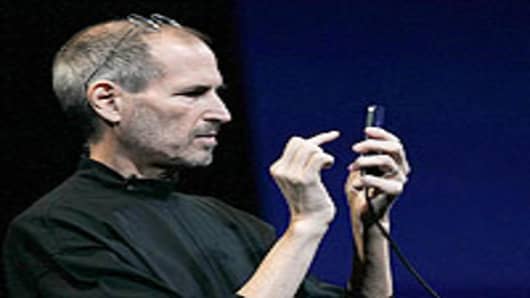Now that Apple has taken the wraps off the 4G iPhone, the next key battleground in the smartphone wars has emerged: video chat on your cell.
This battle will pit Apple against Google, it will set AT&T against Verizon. They already are joined by Sprint-Nextel and Taiwan’s HTC. And Nokia.
In a year or two, tens of millions of you could be doing video chat every day. Your sales staff will see the joy on your face when you praise ’em. You can wave to your kids on the way to the airport for your return trip home. And an obscene phone call could get even more obscene.
A tiny peephole into this voyeuristic battlefield shows up today on the new
iPhone: a front-facing camera that the disciples of Steve Jobs have been praying for especially hard since it showed up on an Apple prototype left behind in a local bar in Silicon Valley two months ago.
Up to now the iPhone had only a backside phone facing out on the world, but for video chat you need a front-facer: a Me-cam.
This is a futuristic face-off of titans, but it will be fought by foot soldiers in the swarm—the thousands of apps developers who will write for the next video revolution.
One of the early entrants: an Israeli outfit called Fring.com, a pioneer in empowering the cell phone with Internet features like free calling and location-based friend updates.
The upstart, founded in 2006, says “tens of millions” of cell-phone users in 200 countries have downloaded its free apps. It is likely that more than five million of ’em already make video calls. Half a million more are downloading Fring every month.
Fring—the name comes from “friend” and “ring”—posted what it says was the world’s first video-chat app for the iPhone in December. It followed up 11 days ago with an app for the Google Android design. Already more than 50 different Android handsets can run Fring, versus just one for Apple.
For which platform would you rather write?
Fring boasts enviable DNA: One backer is Yossi Vardi, the godfather of Israel venture investing and a founding investor in one of the biggest payoffs in Israeli high-tech history: ICQ (“I Seek You”), the instant messaging service that AOL bought for $400 million in 1998. (Fring’s U.S. funders include North Bridge Venture Partners.)
The video-app firm’s CEO and co-founder is Avi Shechter, age 42. He also is a veteran of ICQ, helping AOL build Instant Messenger from 12 million to 150 million users worldwide.
I had wanted to interview him on Friday, but there wasn’t time to set up a camera crew in Israel. So we figured we’d hold Ari’s feet to the fire—let’s try to interview him on Fring. And lo and behold, it worked.
The call is a little herky-jerky, a little hard to decipher. But we were able to complete that call moments after I downloaded the Fring app to a borrowed 3G iPhone. And we reached the CEO more than 5,600 miles away, even though he was on a remote camping trip near the Sea of Galilee.
Which is darned impressive, given that my cell phone drops old-fashioned voice calls all the time in midtown Manhattan.
Coolest thing of all: The call was pretty much free. It sidestepped the AT&T network by using wi-fi to jump onboard the global Internet.
That is why carriers may view Fring warily: Will it reduce their revenue or get customers to use their phones even more? Fring says the latter case will hold sway—its customers use their cell phones five hours a day, compared with an average of only half an hour for customers who use only voice and text.
Either way, video chat is coming soon to a tiny screen near you. The next video revolution is upon us, whether carriers like it or not.
An earlier version of this story said half a million people download the Fring app every day. We regret the error.


